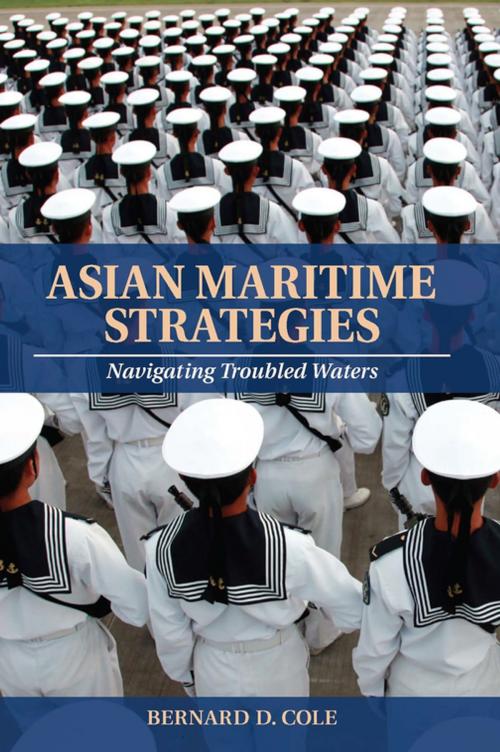| Author: | Bernard D. Cole | ISBN: | 9781612513133 |
| Publisher: | Naval Institute Press | Publication: | October 15, 2013 |
| Imprint: | Naval Institute Press | Language: | English |
| Author: | Bernard D. Cole |
| ISBN: | 9781612513133 |
| Publisher: | Naval Institute Press |
| Publication: | October 15, 2013 |
| Imprint: | Naval Institute Press |
| Language: | English |
This book is concerned with both the national security concerns of Asian maritime nations and the security of the Asian maritime commons. These are defined as the Pacific and Indian Oceans and associated seas, bays, and gulfs, with their included sea lines of communication (SLOCs). The most useful geographical designation for maritime Asia is the Indo-Pacific.” Bernard Cole provides both a survey of the maritime strategies of the primary nations of the Indo-Pacific region and an evaluation of the domestic and international politics that drive those strategies. The United States, Canada, Russia, Japan, North Korea, South Korea, China, the Philippines, Brunei, Indonesia, Vietnam, Singapore, Malaysia, Myanmar, India, Pakistan, Iran, the smaller Indian Ocean and Persian Gulf states are all surveyed and analyzed. The United States, Japan, China, and India not surprisingly draw the most attention, given their large modern navies and distant strategic reach. The author concludes that the United States remains the dominant maritime power in this huge region, stretching from Canada to the Persian Gulf, despite its lack of a traditionally strong merchant marine. U.S. maritime power remains paramount, due primarily to its dominant navy. The Chinese naval modernization program deservedly receives a good deal of public attention, but Cole argues that on a day-to-day basis the Japanese Maritime Self-Defense Force, as its navy is named, is the most powerful maritime force in Far Eastern waters, while the modernizing Indian Navy potentially dominates the Indian Ocean. In fact, a focus of this work is the exemplary description of all the region’s navies, with the author noting the naval arms race that is underway, particularly in the area of submarine acquisition. Cole is careful to couch this phenomenon in the regional concerns about Chinese naval expansion and the desire to ensure a continued, massive U.S. naval presence. The current naval developments in the region evince elements of a naval arms race, but lack the coherent maritime strategies to make naval developments dangerous to regional peace and security. Most telling will be whether United States power and focus remain on the region, while adjusting to continued Chinese maritime power in a way acceptable to both nations. No other current or recent work provides such a complete description of the Indo-Pacific region’s navies and maritime strategies, while analyzing the current and future impact of those forces.
This book is concerned with both the national security concerns of Asian maritime nations and the security of the Asian maritime commons. These are defined as the Pacific and Indian Oceans and associated seas, bays, and gulfs, with their included sea lines of communication (SLOCs). The most useful geographical designation for maritime Asia is the Indo-Pacific.” Bernard Cole provides both a survey of the maritime strategies of the primary nations of the Indo-Pacific region and an evaluation of the domestic and international politics that drive those strategies. The United States, Canada, Russia, Japan, North Korea, South Korea, China, the Philippines, Brunei, Indonesia, Vietnam, Singapore, Malaysia, Myanmar, India, Pakistan, Iran, the smaller Indian Ocean and Persian Gulf states are all surveyed and analyzed. The United States, Japan, China, and India not surprisingly draw the most attention, given their large modern navies and distant strategic reach. The author concludes that the United States remains the dominant maritime power in this huge region, stretching from Canada to the Persian Gulf, despite its lack of a traditionally strong merchant marine. U.S. maritime power remains paramount, due primarily to its dominant navy. The Chinese naval modernization program deservedly receives a good deal of public attention, but Cole argues that on a day-to-day basis the Japanese Maritime Self-Defense Force, as its navy is named, is the most powerful maritime force in Far Eastern waters, while the modernizing Indian Navy potentially dominates the Indian Ocean. In fact, a focus of this work is the exemplary description of all the region’s navies, with the author noting the naval arms race that is underway, particularly in the area of submarine acquisition. Cole is careful to couch this phenomenon in the regional concerns about Chinese naval expansion and the desire to ensure a continued, massive U.S. naval presence. The current naval developments in the region evince elements of a naval arms race, but lack the coherent maritime strategies to make naval developments dangerous to regional peace and security. Most telling will be whether United States power and focus remain on the region, while adjusting to continued Chinese maritime power in a way acceptable to both nations. No other current or recent work provides such a complete description of the Indo-Pacific region’s navies and maritime strategies, while analyzing the current and future impact of those forces.















